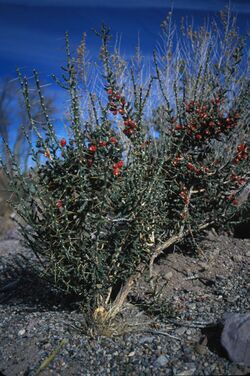Biology:Cylindropuntia leptocaulis
| Cylindropuntia leptocaulis | |
|---|---|

| |
| Scientific classification | |
| Kingdom: | Plantae |
| Clade: | Tracheophytes |
| Clade: | Angiosperms |
| Clade: | Eudicots |
| Order: | Caryophyllales |
| Family: | Cactaceae |
| Genus: | Cylindropuntia |
| Species: | C. leptocaulis
|
| Binomial name | |
| Cylindropuntia leptocaulis F.M.Knuth
| |
| Synonyms | |
Cylindropuntia leptocaulis, the desert Christmas cactus, desert Christmas cholla, pencil cactus, or tasajillo, is a species of cholla cactus.
Distribution and habitat
Cylindropuntia leptocaulis is widely distributed in deserts, grasslands, chaparral, and woodlands in the Southwestern United States and several states in Northern Mexico.[1]
Description
The shrubby Cylindropuntia leptocaulis plants reach .5 to 1.8 m (1.6 to 5.9 ft) tall, reaching the extreme height when supported within desert trees. Branches are narrow, 3–5 mm across. Spines 0-1 (occasionally as many as 3) at each areole. Flowers open in the late afternoon and are pale yellow or greenish yellow, with occasional red tips.[2]
Around December, the plant grows red berries that when consumed, can have an intoxicating effect.[citation needed] The fruits are crushed and mixed with a beverage by the Apache, Chiricahua, and Mescalero to produce narcotic effects.[3]
Gallery
References
- ↑ "Cylindropuntia leptocaulis, Christmas Cactus, Southwest Desert Flora". http://southwestdesertflora.com/WebsiteFolders/All_Species/Cactaceae/Cylindropuntia%20leptocaulis,%20Christmas%20Cactus.html.
- ↑ Anderson, Edward F. (2001). The cactus family. Portland, Or: Timber Press. p. 210. ISBN 0-88192-498-9. https://books.google.com/books?id=vYXQHL2IsZ4C&pg=PA210.
- ↑ Moerman, Daniel (1998). Native American Ethnobotany. Portland, Oregon: Timber Press. p. 367. ISBN 978-0-88192-453-4.
External links
- Cylindropuntia leptocaulis photo gallery at Opuntia Web
- Cylindropuntia leptocaulis in the Lady Bird Johnson Wildflower Center database
Wikidata ☰ Q143948 entry
 |



